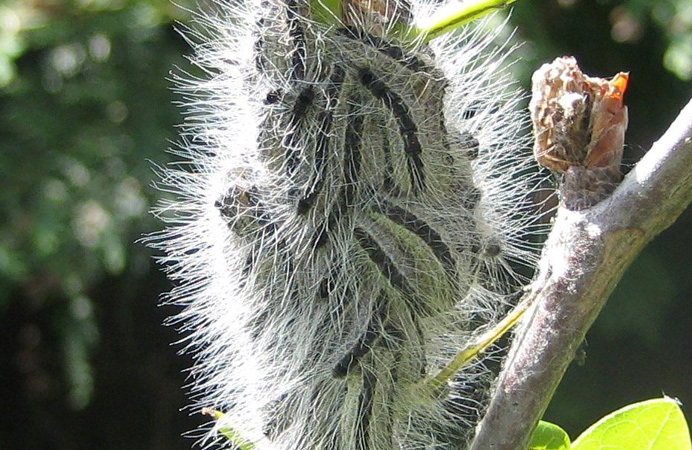With the weather warming up and the days getting longer, it is the time of year when most of us get outdoors to enjoy our gardens and the parks and open spaces around the borough.

However, we are also being reminded to keep an eye out for caterpillar nests in oak trees this summer – and if you spot them, not to get too close.
In recent years, oak processionary moth (OPM) caterpillars have been found on an increasing number of oak trees in the borough and across west London. The caterpillars, which get their name from their habit of moving in nose-to-tail processions, can be a hazard to the trees because they feed on the leaves, and large populations can strip oak trees bare leaving them vulnerable to other pests and diseases.
Not only can the caterpillars be hazardous to oak trees, they can also be harmful to the health of people and animals. This is because they shed thousands of hairs that can become airborne. These tiny hairs contain a toxin that can cause an itchy skin rash and, less frequently, eye and throat irritations or breathing difficulties.
Caterpillars start emerging in April from eggs laid in oak trees the previous summer and the risk to health is at its highest between May and July. Residents are advised to protect themselves, children and pets from the caterpillars and nests by avoiding them when spotted, and to report any sightings.
What to look for
June is the time of year when the caterpillars build their distinctive white, silken, webbing nests, usually

dome or teardrop-shaped on the trunks and branches of oak trees, not among the leaves. The nests are typically about the size of a tennis ball.
Usually white when new, the nests become discoloured to match the colour of the tree’s bark, and can be found anywhere in the tree from the trunk to the main branches. However, they can fall to the ground, where they can be accessible to children and inquisitive animals such as cats and dogs.
What to do if you see a nest
Ealing Council is working with the Forestry Commission to tackle the nests and moth population in its parks and open spaces with a carefully controlled programme of tree treatment and nest removal.
Householders who find evidence of the pest in their own oak trees should report it to the Forestry Commission. You can use its on-line Tree Alert form available at www.forestry.gov.uk/opm1 or, alternatively, you can email opm@forestry.gsi.gov.uk or call 0300 067 4442.
If you see nests or caterpillar keep away and do not try to remove them yourself. Anyone displaying symptoms including skin or eye irritations following possible contact should visit a pharmacist. For more serious reactions consult your GP or call NHS 111. Contact a vet if an animal is affected.

More health advice is available from the ‘Insects that bite or sting’ area of the NHS Choices website, www.nhs.uk/livewell
Do not try to remove the nests
Councillor Bassam Mahfouz, cabinet member for transport, environment and leisure, said: “Residents are advised to be vigilant at home, in schools and any outdoor spaces where there might be oak trees. Infested oak trees should only be treated by qualified operators under strict controls, so we would urge them not to try to remove the nests or the caterpillars themselves because their hairs can cause itching skin rashes and other health problems.”
Alison Field, the Forestry Commission’s south east England director, said: “The public can play an important role in helping to control the pest by reporting sightings. We need reports of the caterpillars or their nests from the public or others, such as gardeners, tree surgeons and ground-care workers, who work or relax near oak trees. However, they should not try to remove the caterpillars or nests themselves. This needs to be carefully timed to be effective, and is most safely done by specially trained and equipped pest control experts.”







